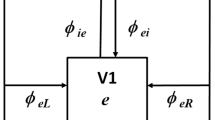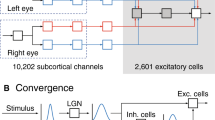Abstract
We derive an activity-based developmental model of ocular dominance column formation in primary visual cortex that takes into account cortical growth. The resulting evolution equation for the densities of feedforward afferents from the two eyes exhibits a sequence of pattern forming instabilities as the size of the cortex increases. We use linear stability analysis to investigate the nature of the transitions between successive patterns in the sequence. We show that these transitions involve the splitting of existing ocular dominance (OD) columns, such that the mean width of an OD column is approximately preserved during the course of development. This is consistent with recent experimental observations of postnatal growth in cat.
Similar content being viewed by others
References
Callaway, E.M., Katz, L.C., 1991. Effects of binocular deprivation on the development of clustered horizontal connections in cat striate cortex. Proc. Natl. Acad. Sci. U.S.A. 88, 745–749.
Chaplain, M.A.J., Ganesh, M., Graham, I.G., 2001. Spatio-temporal pattern formation on spherical surfaces: Numerical simulation and application to solid tumor growth. J. Math. Biol. 42, 387–423.
Crair, M.C., Horton, J.C., Antomini, A., Stryker, M.P., 2001. Emergence of ocular dominance columns in cat visual cortex by two weeks of age. J. Comp. Neurol. 430, 235–249.
Crampin, E.J., Gaffney, E.A., Maini, P.K., 1999. Reaction and diffusion on growing domains: Scenarios for robust pattern formation. Bull. Math. Biol. 61, 1093–1120.
Crampin, E.J., Gaffney, E.A., Maini, P.K., 2002. Mode-doubling and tripling in reaction–diffusion patterns on growing domains: A piecewise linear model. J. Math. Biol. 44, 107–128.
Crowley, J.C., Katz, L.C., 2000. Early development of ocular dominance columns. Science 290, 1321–1324.
Duffy, K.R., Murphy, K.M., Jones, D.G., 1998. Analysis of the postnatal growth of visual cortex. Vis. Neurosci. 15, 831–839.
Ermentrout, G.B., Cowan, J.D., 1980. Secondary bifurcations in neuronal nets. SIAM J. Appl. Math. 39, 323–340.
Harris, A.E., Ermentrout, G.B., Small, S.L., 2000. A model of ocular dominance column development by competition for trophic factor: Effects of excess trophic factor with monocular deprivation and effects of antagonist of trophic factor. J. Comput. Neurosci. 8, 227–250.
Hubel, D.H., Wiesel, T.N., 1977. Functional architecture of macaque monkey visual cortex. Proc. R. Soc. Lond. B 198, 1–59.
Kondo, S., Asai, R., 1995. A reaction–diffusion wave on the skin of the marine angelfish pomacanthus. Nature 376, 765–768.
Luhmann, H.J., Singer, W., Martinez-Millan, L., 1990. Horizontal interactions in cat striate cortex: I. Anatomical substrate and postnatal development. Eur. J. Neurosci. 2, 344–357.
Miller, K.D., Keller, J.B., Stryker, M.P., 1989. Ocular dominance column development: Analysis and simulation. Science 245, 605–614.
Murray, J.D., 2002. Mathematical Biology, 3rd ed. Springer-Verlag, Berlin.
Painter, K.J., Maini, P.K., Othmer, H.G., 1999. Stripe formation in juvenille Pomacathus explained by a generalized Turing mechanism with chemotaxis. Proc. Natl. Acad. Sci. U.S.A. 96, 5549–5554.
Purves, D., LaMantia, A., 1993. Development of blobs in the visual cortex of macaques. J. Comp. Neurol. 334, 169–175.
Rathjen, S., Schmidt, K.E., Lowel, S., 2003. Postnatal growth and column spacing in cat primary visual cortex. Exp. Brain Res. 149, 151–158.
Schmidt, K.E., Galuske, R.A.W., Singer, W., 1999. Matching the modules: Cortical maps and long-range connections in visual cortex during development. J. Neurobiol. 41, 10–17.
Shatz, C.J., Luskin, M., 1986. The relationship between the geniculocortical afferents and their cortical target cells during development of the cat's primary visual cortex. J. Neurosci. 6, 3655–3668.
Swindale, N.V., 1980. A model for the formation of ocular dominance stripes. Proc. R. Soc. B 208, 243–264.
Swindale, N.V., 1996. The development of topography in visual cortex: A review of models. Network: Comp. Neural Syst. 7, 161–247.
Turing, A.M., 1952. The chemical basis of morphogenesis. Phil. Trans. R. Soc. Lond. B 237, 32–72.
Varea, C., Aragon, J.L., Barrio, R.A., 1997. Confined Turing patterns in growing systems. Phys. Rev. E 56, 1250–1253.
Author information
Authors and Affiliations
Corresponding author
Rights and permissions
About this article
Cite this article
Oster, A.M., Bressloff, P.C. A Developmental Model of Ocular Dominance Column Formation on a Growing Cortex. Bltn. Mathcal. Biology 68, 73–98 (2006). https://doi.org/10.1007/s11538-005-9055-7
Received:
Accepted:
Published:
Issue Date:
DOI: https://doi.org/10.1007/s11538-005-9055-7




